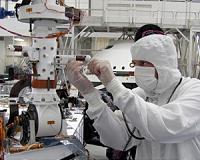 |
Pasadena, Calif. (UPI) Dec 23, 2010 NASA says its next Mars rover will be equipped with a rock-zapping laser able to analyze the chemical composition of rocks and soil from more than 20 feet away. The Chemistry and Camera instrument being installed on the rover Curiosity can hit rocks with a laser powerful enough to turn a pinhead-size sample into a glowing, ionized gas that the instrument will observe through a telescope and, by analyzing the spectrum of light in the gas, identify the chemical elements in the target, ScienceDaily.com reported Thursday. This will help the rover science team survey the rover's surroundings and choose which targets to drill into, or scoop up and collect for additional analysis by other instruments inside the rover, NASA says. Curiosity will launch in late 2011 to land on the surface of Mars in August 2012. An American and French team led by geochemist Roger Wiens with the U.S. Department of Energy's Los Alamos National Laboratory proposed the instrument during NASA's 2004 open competition for participation in the Mars Science Laboratory project. "The trick is very short bursts of the laser," Wiens said. "You really dump a lot of energy onto a small spot -- megawatts per square millimeter -- but just for a few nanoseconds." The pinhead-size spot hit by ChemCam's laser gets as much power focused on it as a million light bulbs, for five one-billionths of a second, Wiens said. Testing of the instrument is ongoing at NASA's Jet Propulsion Laboratory in Pasadena, Calif., in preparation for the launch between Nov. 25 and Dec. 18, 2011.
Share This Article With Planet Earth
Related Links Mars News and Information at MarsDaily.com Lunar Dreams and more
 Spain Supplies Weather Station For Next Mars Rover
Spain Supplies Weather Station For Next Mars RoverPasadena CA (JPL) Dec 01, 2010 The first instrument from Spain for a mission to Mars will provide daily weather reports from the Red Planet. Expect extremes. Major goals for NASA's Mars Science Laboratory include assessing the modern environment in its landing area, as well as clues to environments billions of years ago. The environment station from Spain will fill a central role in studying modern conditions by measuri ... read more |
|
| The content herein, unless otherwise known to be public domain, are Copyright 1995-2010 - SpaceDaily. AFP and UPI Wire Stories are copyright Agence France-Presse and United Press International. ESA Portal Reports are copyright European Space Agency. All NASA sourced material is public domain. Additional copyrights may apply in whole or part to other bona fide parties. Advertising does not imply endorsement,agreement or approval of any opinions, statements or information provided by SpaceDaily on any Web page published or hosted by SpaceDaily. Privacy Statement |